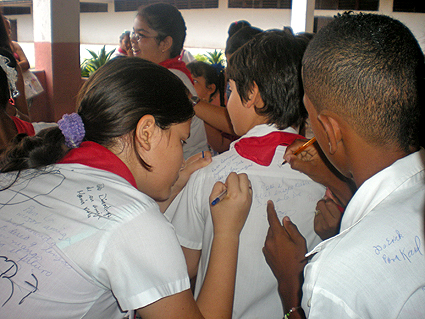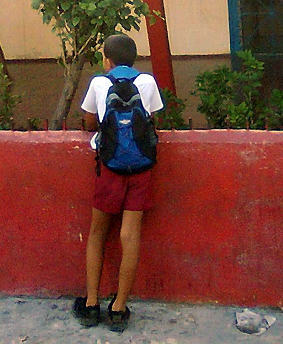School Uniforms
Isbel Diaz Torres

My sister-in-law doesn’t know what she’s going to do. The new school year has already begun but she still doesn’t have the full uniforms needed for her two children.
The youngest is beginning first grade at the elementary school. Since the government gave him an allotment of two pairs of red shorts and two white shirts last year, in pre-school, this year he doesn’t get anything. He has to return to school wearing his old uniform.
Buying the largest sizes that still fit one’s child is the most common strategy. This task, which socially (and wrongly) falls on Cuban mothers, can become what we call here “a true headache.” The first year the garments are sewn to fit, and during the second they come undone at the seams.
The case of the older of my nephews is different. He’s beginning secondary school, where the uniforms vary. Right now he has to wear mustard-colored, long-legged pants and a white shirt. His mother managed to get the two pairs of pants that fit him, size 28. They barely had any clothes of that cut because the immense majority of students wear larger sizes.

He didn’t have the same luck with the shirts. He still hasn’t been able to find any that fit him, simply because there aren’t any in the stores. Our fear is that the boy will have to show up at school wearing his little shirt from elementary school. It’s the only one he still has because the other one was ruined in the popular and amusing tradition of having signatures and messages written on one’s shirt by classmates during graduation.
As a rule, the beginning of junior high school marks one’s entry into adolescence. This is the time in the development of boys and girls when they begin to devote extreme attention to their appearance so as to be more successful in their flirtatious pursuits.
Personal appearance at this stage also plays a decisive role in being accepted into groups that one seeks to join. At the same time, the tremendous activity inside schools gives few guarantees that clothes will last for the two full years that these are supposed to.
For some parents there’s always the alternative of buying the uniform pants or a shirt on the black market for 50 Cuban pesos each (about $2.50 USD). That figure is about ten times the price of these garments sold in the State-run stores. Nevertheless, it’s impossible to ignore that a considerable number of parents (most of them, in my opinion) won’t be able to make such a sacrifice.






I’ve never liked school uniforms or any limitation regarding clothing, for that matter. In my grade school in Plainfield, New Jersey, USA, girls were not permitted to wear pants. My best friend, Birdie, and I decided to protest against that rule at the age of nine. The year was 1971. After returning home for lunch, we decided to change our clothing and we returned to school in pants. The teacher, in a moment of enlightenment, re-examined the ridiculously confining rule and she did something to bring about its elimination. After that day, girls were permitted to wear pants.
But my comment is off subject. I understand the difficulty in getting needs met in Cuba, including acquiring clothing. I grew up with similar problems, as my parents struggled to make ends meet. When other students criticized my appearance, I found their behavior shallow and repulsive. I felt no shame in being poor and, to this day, feel no shame in being poor. The shame belongs to those who deprive others.